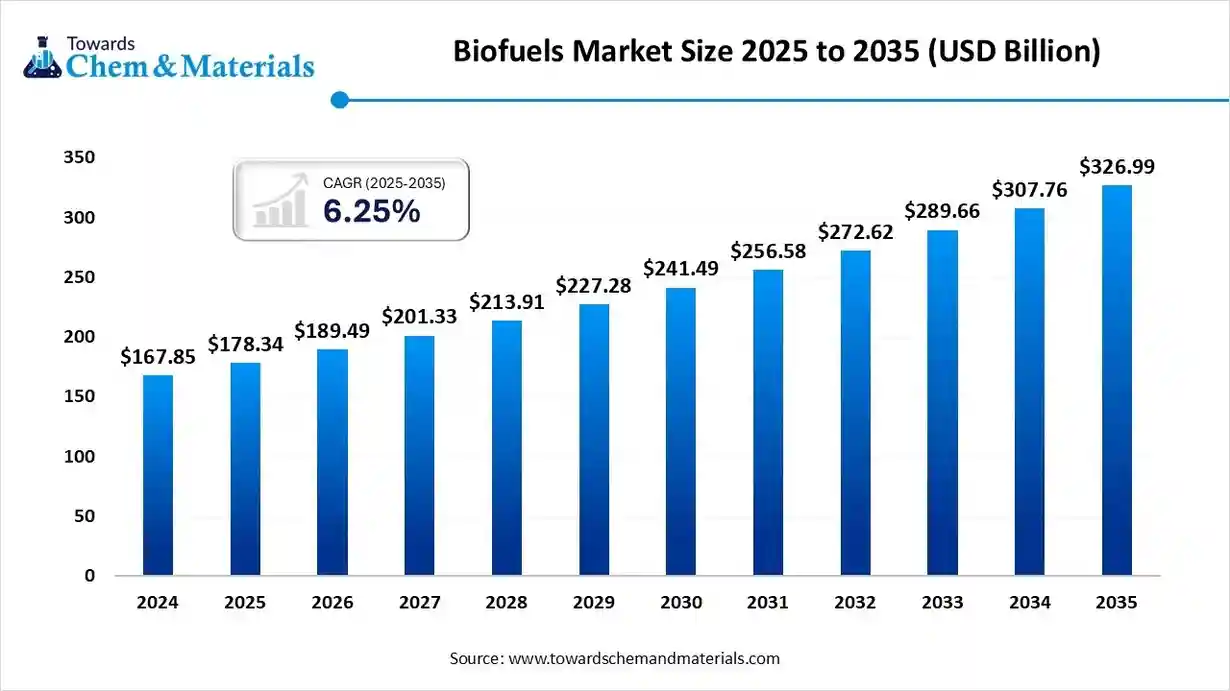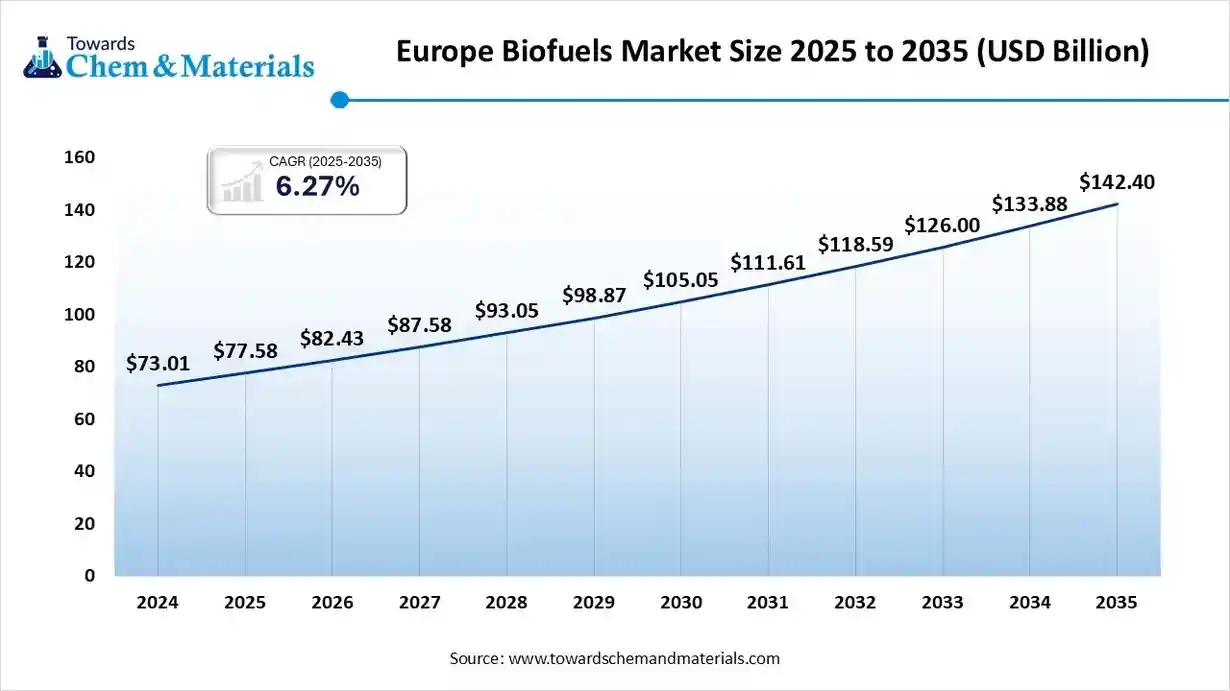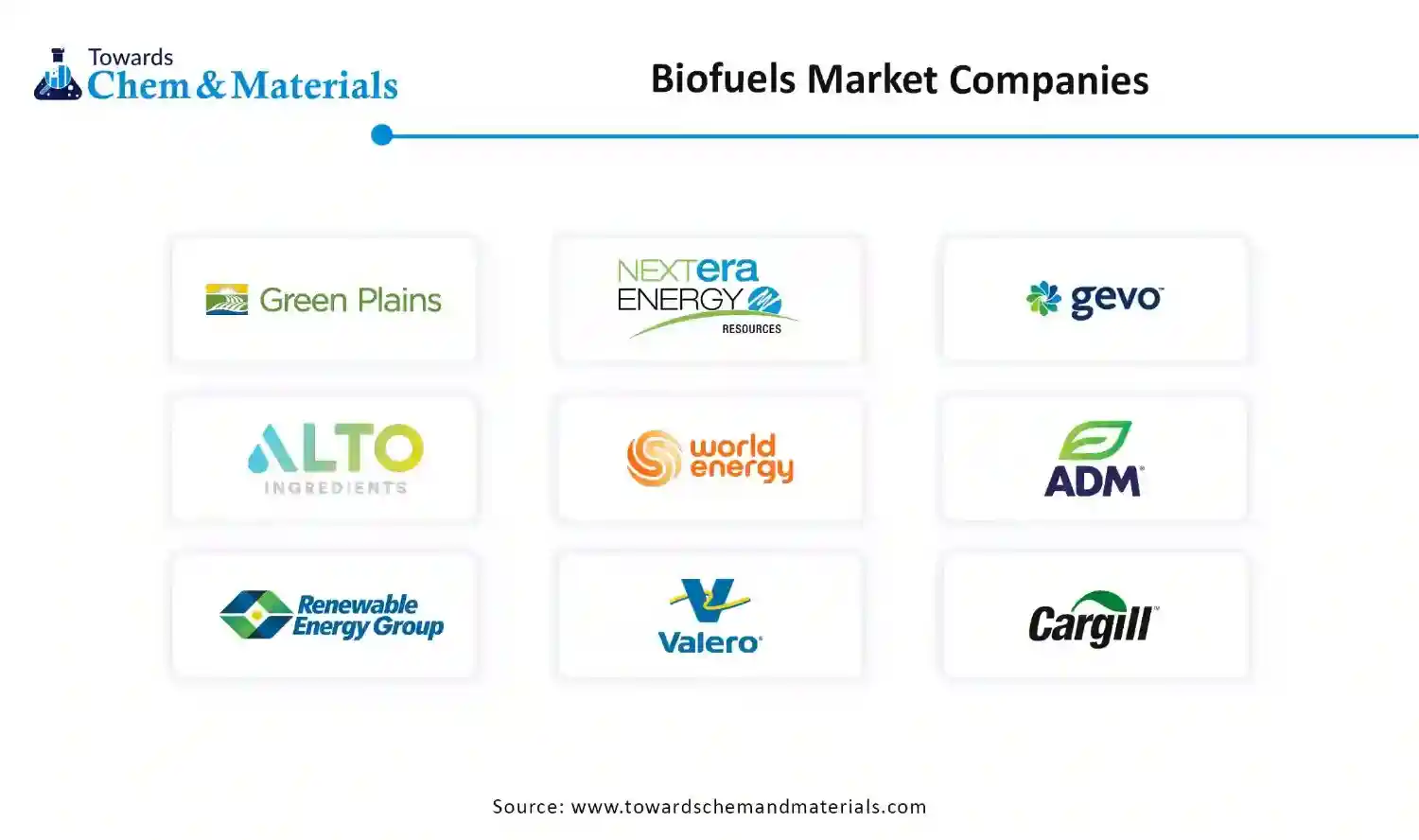November 2025
The global biofuels market size is calculated at USD 178.34 billion in 2025 and is predicted to increase from USD 189.49 billion in 2026 and is projected to reach around USD 326.99 billion by 2035, The market is expanding at a CAGR of 6.25% between 2025 and 2035. Asia Pacific dominated the Biofuels market with a market share of 43.50% the global market in 2024. The growing demand for energy and the depletion of fossil fuels drive the market growth.

Biofuels market growth is strongly supported by global efforts to reduce carbon emissions, as many countries adopt renewable fuel blending mandates and long-term climate targets. According to the International Energy Agency, global biofuel demand is expected to rise by more than 11 percent between 2023 and 2025, driven by expanding government policies that prioritise low-carbon transport fuels. Another key driver is the need for better air quality, since biodiesel and ethanol blends can reduce particulate matter, sulphur emissions, and carbon monoxide compared with conventional fossil fuels, which aligns with public health objectives highlighted by the World Health Organization.
Energy security concerns also add momentum because biofuels help reduce dependence on imported crude oil and support diversification of national fuel supplies. Growing transportation demand in emerging economies strengthens the consumption of liquid renewable fuels in sectors that are difficult to electrify, including aviation, marine transport, and heavy-duty vehicles.
Biofuels are renewable fuels produced from biomass such as agricultural crops, forestry residues, organic waste, and algae. According to the International Energy Agency, biofuels are available in liquid, solid, and gaseous forms, with commonly used types including bioethanol, biodiesel, biogas, and bio-methanol.
They help reduce lifecycle greenhouse-gas emissions compared with fossil fuels, which supports global climate goals highlighted in international energy and environment assessments. Biofuels can also improve air quality by reducing pollutants such as sulphur and particulate matter, aligning with public health priorities identified by the World Health Organization. In addition, they strengthen energy security for many countries by diversifying fuel supplies and reducing dependence on imported petroleum.
| Report Attributes | Details |
| Market Size in 2026 | USD 189.49 Billion |
| Expected Size by 2035 | USD 326.99 Billion |
| Growth Rate from 2025 to 2035 | CAGR 6.25% |
| Base Year of Estimation | 2024 |
| Forecast Period | 2026 - 2035 |
| Leading Region | Europe |
| Fastest Growing Region | Asia Pacific |
| Segment Covered | By Type, By Feedstock, By End-Use Industry, By Region |
| Key Companies Profiled | Green Plains Inc., NextEra Energy Resources, LLC , Gevo Inc. , Pacific Ethanol, Inc. (now Alto Ingredients, Inc.) , World Energy, LLC, POET LLC, Archer Daniels Midland Company (ADM) , Renewable Energy Group Inc. (Chevron Renewable Energy Group) , Valero Energy Corporation, Neste U.S. Inc. , Cargill, Incorporated , Chevron Corporation , BP America Inc. , Shell USA, Inc. |
The biofuels market is experiencing significant technological advances driven by the need for greater efficiency, lower production costs, and improved sustainability across the entire value chain. A central shift is the increasing use of artificial intelligence, which supports real-time optimisation of conversion pathways and improves predictive decision-making for plant operators. Artificial Intelligence systems can analyse variations in biomass composition, moisture levels, and impurity content, which helps manufacturers fine-tune processes such as transesterification, hydrolysis, and fermentation for higher yield and lower energy consumption. These tools also accelerate research on new biofuel molecules by identifying patterns in feedstock behaviour and screening potential catalysts or microbial strains.
In addition, AI supports the efficient use of waste streams by mapping the quality and availability of residues and recommending the most economic routes for biofuel conversion. Companies are beginning to apply AI to improve blending practices, logistics planning and integration of biofuels into existing energy infrastructure. An example is Lootah BioFuels in the United Arab Emirates, which uses AI-based process control to enhance biodiesel yield and optimise feedstock use.
| Generation | Raw Material Used | Conversion Process | Output |
| First Generation (1G) |
|
Fermentation |
|
| Second Generation (2G) |
|
|
|
| Third Generation (3G) |
|
Thermochemical Processes |
|
| Fourth Generation (4G) |
|
|
|
Why the Bioethanol Segment Dominates the Biofuels Industry?
The bioethanol segment dominated the biofuels industry with a 47.6% share in 2024. The growing transportation sector and focus on minimizing greenhouse gas emissions increase demand for bioethanol. The growing energy security demand and the favorable government policies require bioethanol. The cost-effectiveness of bioethanol and the presence of abundant feedstocks like sugarcane & rice drive the overall market growth.The biodiesel segment is growing at a 7.6% CAGR in the market during the forecast period.
The strong focus on lowering carbon monoxide & hydrocarbons emissions and the increasing need for energy security increase demand for biodiesel. The growing use of biodiesel in generators, vehicles, and locomotives helps market growth. The increasing demand for power in areas like schools, residential zones, and hospitals requires biodiesel that supports the overall market growth.
The biogas segment is significantly growing in the market. The strong focus on energy independence and the increasing need for energy security require biogas. The growing applications like cooking, electricity generation, and heating require biogas. The increasing use of vehicles and the rising generation of power require biogas that supports the overall market growth.
How did the Corn & Sugarcane Segment Hold the Largest Share in the Biofuels Market?
The corn & sugarcane segment held the largest revenue share of 48.5% in the biofuels market in 2024. The presence of high starch content and cost-effective conversion processes of sugarcane helps market growth. The increasing demand for high-yield biofuels and the high production volume of biofuels require corn & sugarcane. The well-established industrial and agricultural infrastructure drives the overall market growth.
The algae segment is growing at the fastest CAGR of 7.7% in the market during the forecast period. The strong focus on lowering greenhouse gas emissions and the increasing need for high lipid content require algae. The presence of non-arable land growing wastewater infrastructure increases the production of algae. The growing production of biogas, biodiesel, and bioethanol requires algae, supporting the overall market growth.
The waste oil & fats segment is growing at a significant rate in the market. The strong focus on improving the properties of biofuels and the increasing need for waste management require waste oils & fats. The cost-effectiveness and focus on lowering greenhouse gas emissions require waste oil & fats. The strong presence of waste oils and fats supports the overall market growth.
Which End-Use Industry Dominated the Biofuels Market?
The automotive segment dominated the biofuels market with a 54.3% share in 2024. The growing road transport and increasing need for heavy transport vehicles require biofuels. The increasing use of commercial vehicles and light-duty passenger cars increases the adoption of biofuels. The strong focus on lowering greenhouse gas emissions and the expansion of the automotive sector require biofuels, driving the overall market growth.
The aviation segment is growing at a 7.8% CAGR in the market during the forecast period. The decarbonization goals in the aviation industry and strong government support for the adoption of SAF require biofuels. The increasing demand for sustainable & conventional jet fuels and the rise in air travel require biofuels. The focus on lowering emissions and initiatives like CORSIA require biofuels, supporting the overall market growth.
The marine segment is significantly growing in the market. The strong focus on lowering greenhouse gas emissions and regulations like the EU ETS requires biofuels. The focus on energy security and the increasing need for energy independence require biofuels. The availability of bio-LNG, FAME, & HVO and the increasing marine shipping support the overall market growth.
The Europe biofuels market size was valued at USD 178.34 billion in 2025 and is expected to reach USD 326.99 billion by 2035, growing at a CAGR of 6.25% from 2025 to 2035. Europe dominated the biofuels market with a 43.5% share in 2024.

The well-established distribution & bio-refineries systems and sustainability policies like RED III increase demand for biofuels. The strong focus on energy security and the increasing need to lower greenhouse gas emissions require biofuels. The climate neutrality goals and presence of key feedstocks increase the production of biofuels. The growing investment in biofuel production facilities and innovations in conversion technologies drives the overall market growth.
Green Transition: What is Germany's Role in the Biofuels Revolution
Germany is a key contributor to the biofuels industry. The government targets for renewable energy and a shift towards sustainable fuels increase demand for biofuels. The increasing investment in renewable energy sources and decarbonization goals requires biofuels. The growing demand for electric mobility and a strong focus on energy security require biofuels. The growing expansion of the transportation sector and the expansion of HVO, driving the overall market growth.
Asia Pacific Biofuels Market Trends
Asia Pacific is growing at a 9.0% CAGR in the market during the forecast period. The strong focus on energy independence and the growing need for sustainable energy make biofuels essential. The availability of feedstocks such as agricultural waste, sugarcane, and palm oil increases biofuel production. Government initiatives, such as the Ethanol Blending Program and mandates for biodiesel, support overall market growth.
From Farms to Fuel: India’s Contribution to the Biofuels Boom
India is a major contributor to the biofuels market. The availability of abundant feedstocks, such as agricultural residues and sugarcane, increases biofuel production. The government initiatives, like the National Policy on Biofuels, and programs like SATAT require biofuels. The growing demand for domestic energy security and commitments to address climate change are driving biofuels demand, supporting overall market growth.
Biofuels Market Share, By Region, 2024 (%)
| Regional | Revenue Share |
| North America | 20.32% |
| Europe | 43.50% |
| Asia Pacific | 25.88% |
| Latin America | 6.19% |
| Middle East and Africa | 4.11% |
North America Biofuels Market Trends
North America is growing rapidly in the biofuels industry. The presence of abundant agricultural resources, such as biomass, corn, & soybeans, in countries like Canada and the U.S. supports market growth. The increasing investment in biofuel refineries and well-established biofuel infrastructure helps market growth. Strong government support through initiatives such as the Inflation Reduction Act’s tax credits and the presence of advanced biofuels drive overall market growth.
Biofuel Boom: United States Contribution towards Clean Energy
The United States is growing rapidly in the biofuels market. Government policies, such as the Renewable Fuel Standards and increased awareness of air pollution, increase demand for biofuels. The presence of diverse feedstocks, such as recycled cooking oil, wood, and crop waste, increases biofuel production. The growing expansion of the aviation & transportation sector and the high availability of SAF & renewable diesel support the overall market growth.
Powering Progress: Biofuels Industry Expansion in South America
South America is growing significantly in the biofuels market. The well-established agricultural sector and the presence of abundant resources, such as soybeans & sugarcane, increase biofuel production. The strong focus on reducing fossil fuel dependence and on lowering GHG emissions requires biofuels. The growing investment in biofuel production and climate change goals drives the overall market growth.
Brazil biofuels Industry Trends
Brazil contributes to the growth of the biofuels industry. The abundance of feedstocks such as corn & sugarcane, along with stringent climate goals, increases demand for biofuels. The strong focus on energy security and growing production of SAF & green diesel help market growth. Government initiatives, such as the RenovaBio Program, and innovations, such as flex-fuel vehicle technology, support overall market growth.
Middle East & Africa Biofuels Market Trends
The Middle East & Africa are growing in the biofuels market. The growing demand for energy and the strong focus on energy security are driving the adoption of biofuels. Government subsidies for biofuel production and investment in renewable energy projects help drive market growth. The availability of feedstocks such as sorghum & sugarcane increases biofuel production, driving overall market growth.
Saudi Arabia biofuels Sector Trends
Saudi Arabia is growing rapidly in the biofuels sector. The growing investment in research & development of biofuel and Saudi Green Initiatives helps market growth. The growing consumption of energy and increasing awareness of environmental issues are driving demand for biofuels. The availability of feedstocks such as used cooking oil, agricultural waste, and municipal solid waste increases biofuel production, supporting overall market growth.

By Type
By Feedstock
By End-Use Industry
By Region
November 2025
November 2025
November 2025
November 2025